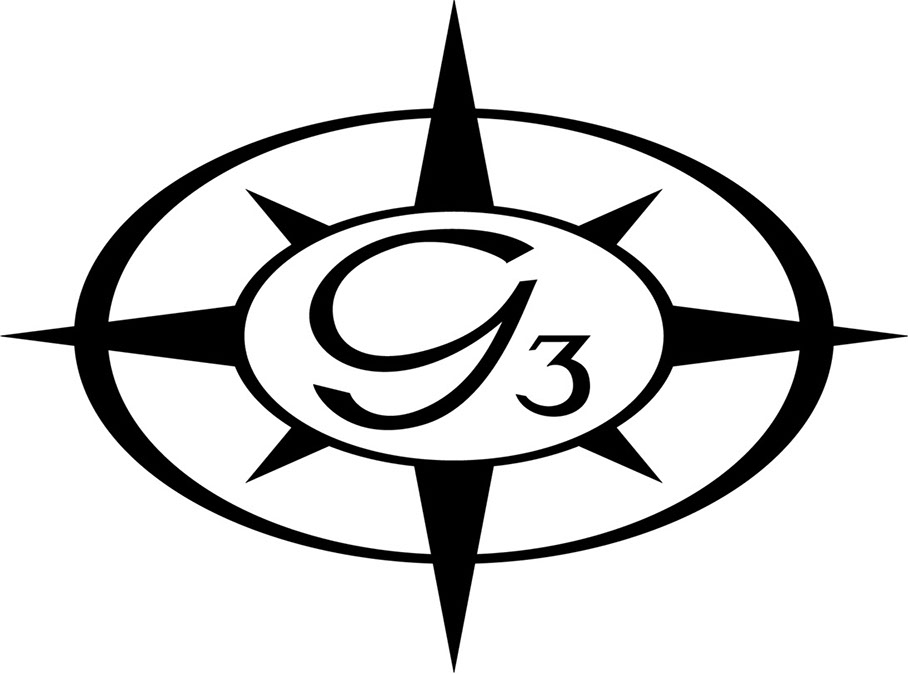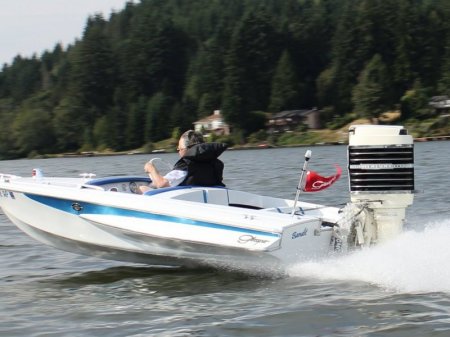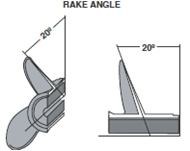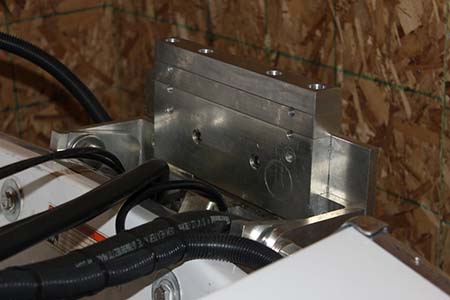G3 Owners Association
www.G3owners.com

Props, Slip and Tests
By Dean Lofall
I am by no means an expert on propellers or on G3 propulsion power. What I am is a tenacious. I spent much of the 2012 boating season, borrowing propellers, buying propellers and keeping real good notes about the propellers I tried. In my story, I don't intend to teach the pros anything, in fact they may have other explanations for my observations. But for the inexperienced, I believe this story has a lot to offer: Saving money, sweat and tears.
Bandit is my 1959 Santa Ana built G3, it is powered with a 1963 Mercury 850. The motor shares the same "Tiger" series engine block with the famous Merc 1000 that began manufacture in 1962. There are a few things that are done to detune 1000 into an 850; that being smaller throat carburetors, absence of the tuned exhaust plate and smaller reeds and reed stops. With the help of Dr. Frankenmerc (Thom Adams), I managed to acquire and install Merc 1000 carbs and tuned exhaust, so while I am not at a full 1000 configuration, my 850 puts out power somewhere between 90 and 95 hp.
But this story isn't about what I did to Bandit's engine, but rather my experience in testing propellers and playing with the setup of the engine. There wasn't much to reference material on the web, so I picked brains of a few, and I tested and tested and then I tested some more. In the end, I had found a configuration that had Bandit running 9 MPH faster than when I started, and a prop that held its grip even when over-trimmed and turning hard.
Propeller Pitch
When most folks think about finding the right prop for their boat, they consider first, engine maximum RPM. This is important! You must select a propeller that based on your specific boat, which doesn't allow the motor, at wide open throttle (WOT), to turn too fast (over-rev) or to turn to slow (lugging). As a general rule of thumb, for each inch of pitch you change, you affect the WOT engine RPM by 200. There are other factors that play into this, specifically lower unit reduction ratio... but in any case, you need to pay attention to your engine RPM when trying props, and know that lugging an engine can be just as damaging as over-revving it.
On Bandit, I tested 17, 18, 19 and 21 inch pitch propellers.
I quickly found that there were as much difference in performance using various propeller manufacturers and types, as there were in changing pitch. My point is, that slapping on a prop that gets you the right engine RPM at wide open throttle is just the start of finding the right prop for maximum performance.
Cup or no cup?
We have all heard that cup is good... it gives you a little more effective pitch, and reduces the prop's tendency to cavtate. All very true. The worst prop I tried was an old Kiekhauffer 19P two blade bronze prop. During minimal trim or slight cornering, it would break loose in a big way. This prop had absolutely no cup at all. The next worse props were the stock Michigan three-bladed props without cup. They were not as bad as the two blade Kiek props, but still would scare the crap out of you when the engine breaks loose at wide open throttle. The third blade, allowed a little harder turns and more aggressive trim, but not enough trim to make Bandit fly while holding good traction. I also found that different cupped props worked better than other cupped props. But we'll get back to this later. So cup all the way! Don't waste your time on a non-cupped propeller.
 Balancing act: Trim, RPM and lift
Balancing act: Trim, RPM and lift
One thing that became apparent for optimum speed on Bandit, was that it came down to a simple balance of lift and RPM and the appropriate prop and trim to achieve this. Too much lift, the G3 becomes unstable, not enough lift means not enough speed. The thing that wasn't clear for me in the beginning, is that lift comes from both trim and from prop design... and at the same time the proper amount of lift needs to happen at just the right engine RPM. Sure, you can trim your engine and lift the bow, but then the question is, are you turning the right RPM to maximize power. Are you reaching the right amount of lift, RPM and speed all at the same time?
But too much lift causes instability, and in the case of too much lift in a G3, it starts to chine-walk. For those that have not experienced this, its is an instability that is very dangerous and there is no way to get out of it but to hold a straight line and slowly back out of the gas. Chine walk can become very severe, to the point that you can end up out of the boat.
So attaining the best performance in Bandit was figuring out what the best balance of lift and RPM. I am done with this project, after achieving what I felt to be the very best configuration: I reached 55 mph at 6200 RPM. This was also achieved at very low prop slip, telling me that I couldn't improve my situation with propeller selection or engine setup any further. So let's move on.
High Rake Props
 You will read that a high rake prop provides a lot of bow lift. The problem that I found with the props I tested, was that too much rake, meant the bow would come up too much, and the boat would become unstable before I reached my highest potential RPM and speed. Where my best 19" pitch prop had me running top speed at 6200 engine RPM before the first signs of instability started to show... My best speed with a high rake prop (a modern Quicksilver Laser II) had my bow too high and the boat starting to chine walk at around 5 MPH less at 52-5400 RPM. My best speed prop turned out to be a 30+ year old design, Quicksilver stainless prop with much less rake. This prop allowed me sufficient trim to gain the engine RPM I needed, and minimized inherent lift so the boat remained stable.
You will read that a high rake prop provides a lot of bow lift. The problem that I found with the props I tested, was that too much rake, meant the bow would come up too much, and the boat would become unstable before I reached my highest potential RPM and speed. Where my best 19" pitch prop had me running top speed at 6200 engine RPM before the first signs of instability started to show... My best speed with a high rake prop (a modern Quicksilver Laser II) had my bow too high and the boat starting to chine walk at around 5 MPH less at 52-5400 RPM. My best speed prop turned out to be a 30+ year old design, Quicksilver stainless prop with much less rake. This prop allowed me sufficient trim to gain the engine RPM I needed, and minimized inherent lift so the boat remained stable.
Propeller Slip
Propeller slip is defined as the loss, expressed in percent, between theoretical boat speed and actual boat speed. The lowest slip is attained by the minimal drag on the boats surfaces (below and above water), the most efficient propellers, and the most efficient engine setup. Engine setup speaks of how the engine is mounted vertically, the amount of trim used to add to lift, and the right prop. Race boats can run better than 5% slip, while most boats run in the 10-20% slip range. After a lot of work, Bandit ran at 5% slip. Which I am very proud of. For more information about engine setup and slip, see the "Secrets of Boat Setup" by Ken Cook.
At the end of this article, I am provide an Excel Spreadsheet that you can download and use to determine theoretical speed and slip speeds for your boat.
Engine Setup Height
It is well known engine height affects the amount of drag in the water. Mercury Marine reports in its owner's manual that for every inch you raise your engine, you can increase the boat speed by 1-2 MPH. There are limitations of how much you can raise the engine in respect to cooling water intake operation and by air injestion. Bandit's cavitation plate was set at 2.5" above the bottom of the boat when it was configured. Later I added two more inches of height (for a total of 4.5") to see what effects it would have. I realized 4 more MPH at top speed. However, the hole shots suffered slightly, where the engine/propeller would spin up until the boat was moving along on a plane, where then it would "lock up" and hold a good bite. This amount of hole shot slippage was not uncomfortable, though it would not work well for water skiing. Bandit's motor is bolted to a CMC Tilt & Trim unit, so my modifications are such that I can easily add and remove one or two inches of engine height is relatively easy.
Partial Summary of Results
While I tested many more props than are shown on this list below, here are some of my basic results that I've talked about in this article.
Boat specifications: 1959 G3, 1963 Merc 850 (approx 95 flywheel hp), short shaft, one person in boat.

| MFR | Type | Size | Blades / Cup | Top Speed | Engine height* |
| Quicksilver | Stainless | 13.5D x 19P | 3 / Yes | 55 | 4.5" |
| Quicksilver | Stainless | 13.5D x 19P | 3 / Yes | 51 | 2.5" |
| Quicksilver Black Diamond |
Aluminum | 13.25D x 19P | 3 / Yes | 49 | 2.5" |
| Michigan Wheel | Aluminum | 13D x 19P | 3 / No | 46 | 2.5" |
| Mercury Marine | Stainless - Chopper | 14D x 18P | 3 / Yes | 45 | 2.5" |
| Vintage Kiekhaufer | Bronze | ?D x 19P | 2 / No | 43 | 2.5" |
* Engine height is measurement from bottom of the boat to the cavitation plate while engine is trimmed perpendicular.
Engine Slip Calculator for Excel 97 and later.
To download our Propeller Slip and theoretical Speed Calculator for MS Excel, click here download.
Contact us: info@g3owners.com
© 2014 - G3Owners.com - All rights reserved. Photographs are property of their respective owners. If your boat photograph ended up on this site and you dont want it here please contact us and we will remove it immediately!